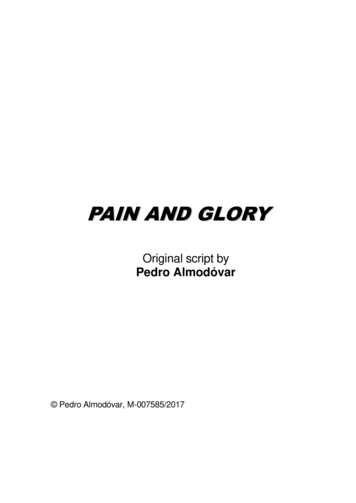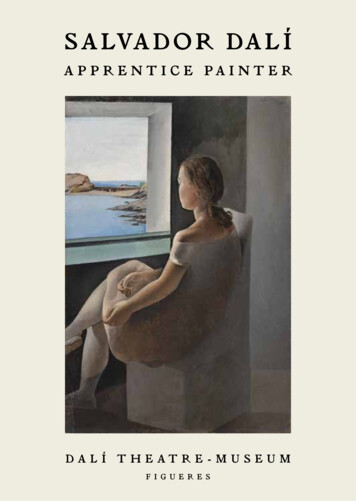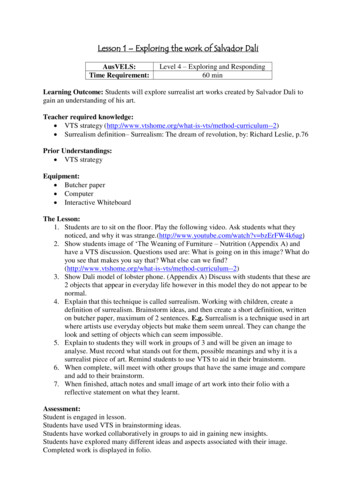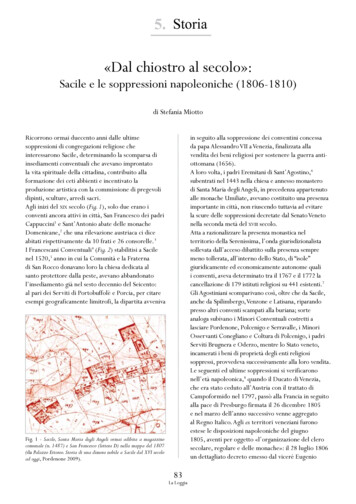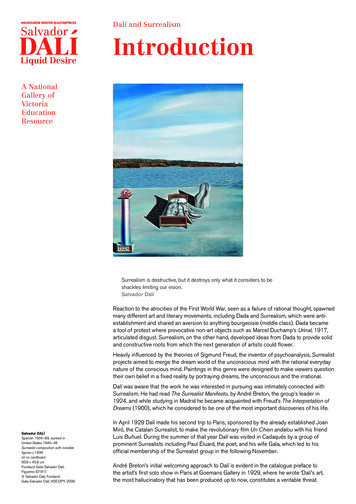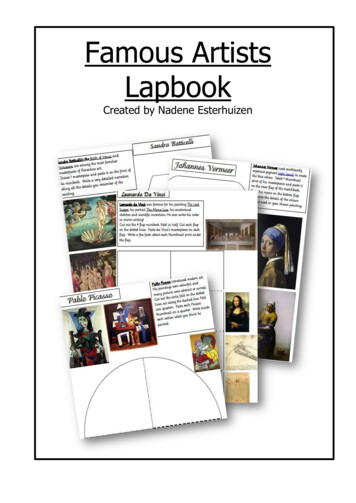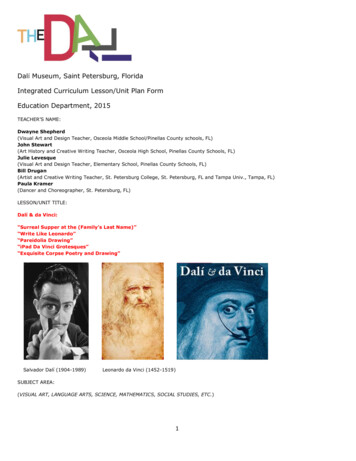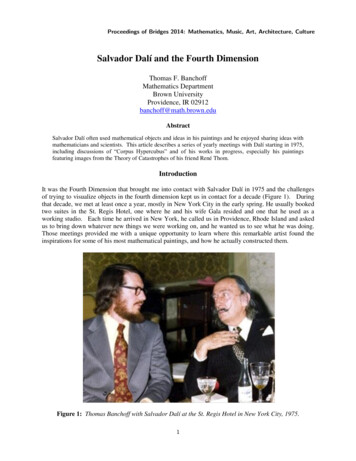
Transcription
Proceedings of Bridges 2014: Mathematics, Music, Art, Architecture, CultureSalvador Dalí and the Fourth DimensionThomas F. BanchoffMathematics DepartmentBrown UniversityProvidence, IR 02912banchoff@math.brown.eduAbstractSalvador Dalí often used mathematical objects and ideas in his paintings and he enjoyed sharing ideas withmathematicians and scientists. This article describes a series of yearly meetings with Dalí starting in 1975,including discussions of “Corpus Hypercubus” and of his works in progress, especially his paintingsfeaturing images from the Theory of Catastrophes of his friend René Thom.IntroductionIt was the Fourth Dimension that brought me into contact with Salvador Dalí in 1975 and the challengesof trying to visualize objects in the fourth dimension kept us in contact for a decade (Figure 1). Duringthat decade, we met at least once a year, mostly in New York City in the early spring. He usually bookedtwo suites in the St. Regis Hotel, one where he and his wife Gala resided and one that he used as aworking studio. Each time he arrived in New York, he called us in Providence, Rhode Island and askedus to bring down whatever new things we were working on, and he wanted us to see what he was doing.Those meetings provided me with a unique opportunity to learn where this remarkable artist found theinspirations for some of his most mathematical paintings, and how he actually constructed them.Figure 1: Thomas Banchoff with Salvador Dalí at the St. Regis Hotel in New York City, 1975.1
BanchoffAs my colleague Charles Strauss said when we were firstinvited, “The worst we can get out of it is a good story”and indeed we ended up with a number of good stories.Dalí is the most unusual person I have ever met (includingmathematicians!)Dalí painted the masterpiece, “Corpus Hypercubus”, in1954 (Figure 2). It is rated as one of his most popular andrecognizable paintings, right after the melted clocks.While the deformed clocks are often considered statementsabout space-time, “The Crucifixion”, as it was originallycalled, makes a statement about four-dimensional spaceand soon it became known by its geometric name.One year after, in 1955, I visited the Metropolitan Museumof Art in New York City for the first time; I was aseventeen-year-old high school student. In my junior-yeardaybook, I made a note on a date in August: “SalvadorDalí’s ‘Crucifixion’ is impressive.” I could not haveimagined what effect that encounter with the artist wouldhave on my own career.Figure 2: “The Crucifixion—Corpus Hypercubus”, Dalí,Metropolitan Museum of Art, 1954.BackgroundI first read about the fourth dimension in 1948 when I was about ten years old. There was a story in aCaptain Marvel comic book (now known as “Shazam”) about a visit to a futuristic laboratory wherescientists “were working on the seventh, eighth, and ninth dimensions”. A thought balloon went up fromthe boy reporter: “I wonder whatever happened to the fourth, fifth, and sixth dimensions?” That ideaabout higher dimensions captured my imagination and I decided to keep at it. I’m still wondering.Later on, another science fiction comic book called “Strange Adventures” also influenced me. In it, “TheCaptured Cross-Section” told about an amorphous blob that appeared out of nowhere, grew to amaximum size and then shrank down and disappeared. The scientist character explained that it must havecome from the fourth dimension, and he demonstrated the dimensional analogy by poking his fingerthrough a paper napkin. A square living in the napkin, he said, could watch as the circle slice grew, thenreceded and disappeared as he withdrew his finger.By the time I was sixteen, I had even formulated a theory of the Trinity based on that dimensionalanalogy, and I would tell it to any teacher or classmate who would listen. By then, I had also read“Flatland” and I knew how to mirror the visit of the Sphere through the plane by inflating and deflating aballoon to simulate a visitation of a Hypersphere through our space.2
Salvador Dalı́ and the Fourth DimensionThat slicing sequence from the “Strange Adventures” comic was at the heart of my theory of the Trinityand the Fourth Dimension. I developed it further when I wrote a major term paper in an honors theologyclass as a sophomore in college. My bibliography included twenty items, a very large number for the olddays when finding references required searching the Periodical Index of Literature. Just a few years later,I found the number of references to the fourth dimension increased very quickly. It accelerated even moreonce computer searches became common.Higher-Dimensional Polyhedral SurfacesWhen I was working on my PhD thesis underProf. Shiing-Shen Chern at the University ofCalifornia, Berkeley, I remembered Dalí’sunfolded hypercube (Figure 3). I needed tounderstand analogues of convexity for objectslike the torus, and that led me to investigatepolyhedral surfaces in three-space with theproperty that any plane would separate theminto at most two pieces.Smooth surfaces with this “two-pieceproperty” shared rigidity characteristics withsmooth convex surfaces in that any twoisometric surfaces of this type had to becongruent. But my first results exhibited a pairof polyhedral objects with the two-pieceproperty that were not congruent. I recognizedthat polyhedral tori with sixteen quadrilateralfaces were projections into three-space of atorus in four-dimensional space built fromsquare faces of a hypercube. It was only laterthat I made the connection between thispolyhedral surface and the fold-out model ofthe hypercube, the central figure in Dalí’s“Corpus Hypercubus” (Figure 2).Figure 3: Unfolding Hypercube Sequence,“Beyond the Third Dimension” [1].Back in graduate school, Prof. Chern introduced me to Nicolaas Kuiper, a visiting professor fromAmsterdam. Kuiper had recently proved results for smooth surfaces in four- and five-dimensional spacesatisfying a condition equivalent to the TPP. His results showed there were no smooth surfaces with thisproperty in any dimension greater than five. When we talked, Kuiper suggested that I prove analogousresults for polyhedral surfaces, but after two weeks, I discovered that it was possible to construct TPPsurfaces with square faces in cubes of any dimension. The polyhedral theory was totally different fromthe smooth theory, a surprising situation. Analyzing these examples proved to be the basis for my PhDthesis in 1964.When I started giving talks about my thesis results, I showed a polyhedral model that could be assembledin six-space to form a surface with the TPP, and I learned how to fold it flat into a plane. Folding a related3
Banchoffpolyhedron, I constructed the hypercube, the central figure in Dalí’s painting. In 1975, it was a picture ofthat unfolded model which brought me in contact with Dalí.In 1967, I began teaching at Brown University. A colleague found out about my interest in fourdimensional geometry, and introduced me to the work of computer scientist Andy van Dam. It wasAndy who directed me to his recent PhD student Charles Strauss who had constructed a “threedimensional blackboard” for interactive industrial design. Charles was looking for new applications.Since I had a great many visualization problems that needed new techniques, it was a naturalcollaboration and Charles and I worked together for the next twelve years.One of our first projects was a study of a hypercube formed by translating a three-dimensional cube in afourth direction and then projecting the resulting polyhedron back into three-space. With relativelyprimitive equipment, we photographed individual images and put them together to create a 16 mm film ofthis object as it rotated in four-dimensional space. Using the analogue of the mapmaking technique ofstereographic projection we produced a remarkably beautiful sequence of images of a torus turning insideout, called “The Flat Torus in the Three-Sphere”. We were hooked.By 1973, when I went to UCLA on my first sabbatical, we had already produced early versions of filmson “The Hypercube: Projections and Slicing” as well as a film we called “Complex Function Graphs.Meeting DalíWe had produced a number of computer-animated films by 1975, and we had begun to investigatestereoscopic slides. In January of that year when I was on my way to the Joint Math Meetings inWashington DC, one of the public relations persons at Brown University introduced me to his associateTom Zito, a staff writer for the Washington Post newspaper. He interviewed me for a couple of hours in arestaurant, stopping whenever I mentioned a name or a technical term to make sure he had the correctspelling. He had a photographer take a picture of me holding an unfolded hypercube. The very nextmorning his article appeared in the Style Section of the Post, with a picture of me showing the unfoldedsurface and with an inset of the Dalí “Corpus Hypercubus” in the background. There was also a pictureof the rotating hypercube, with the rotational effect indicated by afterimaging. When I spoke to thewriter the next day, he asked what I thought of the article (Figure 4). I liked it, I said, but he was abashedwhen I pointed out that he had misspelled my name throughout the article!Figure 4: (Left) Washington Post Style Section, January 22, 1975, page 1, (Right) Washington PostStyle Section, January 22, 1975, page 2.4
Salvador Dalı́ and the Fourth DimensionWhen I got back to Brown, Charles said he was surprised that the Post had printed the Dalí painting sinceit was clear that they had not had time to go through proper procedures to acquire the rights to reproducethe image. It was well known that Dalí liked publicity, but on his own terms. I was slightly alarmedwhen I returned from teaching class one day to find a note from the secretary asking me to contact aperson in New York City “representing Salvador Dalí”. Charles said, “It’s either a hoax or a lawsuit”.When I called back, a woman who identified herself as Senor Dalí’s appointments secretary said that hewas in New York City and he wanted to meet us. Could we come down? I asked Charles what hethought, and he came up with his good line: “Well, it’s either a hoax or a lawsuit, but the worst we can getout of it is a good story.”We came down to New York City by train and met with Dalí in the cocktail lounge of the St. Regis Hotelwhere he more or less held court. A number of visitors arrived and were received by Dalí, and we wereseated at his right and left side as “the ambassadors from mathematics land”. He had just finished aproject on holographic images and he was embarking on a series of stereoscopic oil paintings so hewanted to discuss viewing techniques. I was impressed by his background knowledge and his questionsabout our stereo slides of surfaces in four-space. When I showed him my folding hypercube, he wasquite taken with it and he said, “I may have this.” It was not exactly a question. When I asked him to saymore, he said that he had just established a museum in Figueres, near his birthplace in Catalonia, and thathe wanted to put a version of this moving model as a display. I agreed.Figure 5: (Left) Thomas Banchoff and Charles Strauss, 1980, (Right) Veronese Surface Sequence.5
BanchoffHe was very interested in our stereo films. He asked for a return visit two weeks later to show him ourinitial version of the Veronese surface, a nineteenth century representation of the real projective plane(the unique smooth surface with the TPP in five-space, as proved by Kuiper) (Figure 5). He wanted meto meet two of his main collectors, A. Reynolds Morse and Eleanor Morse who had stayed in New Yorkan extra day at his insistence. We brought our elementary “beam-splitting” apparatus and glasses withpolarized lenses and discussed the value of the stereo effect, which was not as dramatic as Dalí hadhoped. He did become excited by the appearance of the patterns of folds and cusps in the changing viewsof the surface, in particular the three-cusped hypocycloid that he recognized as an “elliptic umbiliccatastrophe”. I was impressed that he was familiar with the images from the catastrophe theory of ReneThom. Only later did I realize that he was already interacting with Thom and that those same imageswould appear in his final paintings.Projects from Yearly VisitsIn our visit the following year in 1967, we sawthe “Dalí Lincoln” or “Lincoln in DalíVision”when it was still in process (Figure 6). Ablack-and-white study from Bell Laboratorieshad reduced a portrait of Abraham Lincoln to acollection of grey squares, and Dalí saw theopportunity to incorporate it into a coloredpainting that would look entirely differentwhen viewed from various distances, aphenomenon he had already achieved in earliercanvases. We saw him looking through thesmall end of a pair of opera glasses to see whatthe view would be like from twenty metersaway, after which he would go up to modifythe color in one square, then repeat the process.Seeing him at work was enlightening.Figure 6:“Gala Contemplating theMediterranean Sea which at Twenty MetersBecomes the Portrait of Abraham Lincoln(Homage to Rothko)” by Salvador Dalí, 1976.In another visit the following year, we saw Dalíworking on two separate pictures by Raphaelfrom the Vatican Apostolic Palace,“The Schoolof Athens” and “The Fire in the Borgo”. Bothare set into the same half-elliptical frames so ifthey are viewed stereoscopically, the mindwants them to fuse the images in the left andright eyes but the set-up causes “retinal rivalry”. The contents switched back and forth from the right eyeto the left. When I saw the piece in progress, there were no additional elements present, but ultimatelyDalí inserted a stereo pair of a collection of overlapping colored rectangles to force a binocularinterpretation (Figure 7).6
Salvador Dalı́ and the Fourth DimensionFigure 7: “The School of Athens” and “The Fire in the Borgo”, Dalí, 1979.In 1980, Dalí was excited about a new project involving distorted perspective, the “hundred meter horse”.The idea was that you would come out of a museum and find yourself looking up at the front view of alarge statue of a horse in perfect proportions. Only as you moved to the side would it become clear that infact the horse was greatly distended, with shoulders several meters away and the rump far away, thelength of a football field (Figure 8, Left).Figure 8: (Left) The Hundred-Meter Horse, signed sketch by Dalí, 1980, (Right), Horse from the Earthto the Moon, Sketch by Dalí, 1982.Dalí had a plaster model of a horse sent to us and Charles set up a scanner to produce a set of horizontalcurves. We then applied various geometric transformations to show perspective projections fromdifferent viewpoints (one was the view from inside the horse, the “Trojan Soldier’s View of the World”).I brought our working images to the opening of Dalí’s exhibit of stereoscopic paintings at theGuggenheim Museum in New York City, and curious onlookers watched from a distance as I sat withDalí in New York City on a side bench as he looked at the preliminary slides. The invitation to that showincluded the picture of the woman with the distended upper leg, similar to “The Ghost of Vermeer thatCan Also Be Used as a Table” from the A. Reynolds Morse collection at the Dalí Museum in St.Petersburg FL.7
BanchoffIn 1981, Dalí wanted to propose a change of scale. Instead of a hundred meters, the horse would be onehundred kilometers long, with the shoulders several kilometers away and the rump on the crest of amountain. The sketch showed Toledo in the distance. No additional calculations were necessary sincethe only change was one of scale. The same mathematics would work for all sizes, although it wasbecoming clearer that it was unlikely that the project would actually be built.The third time we discussed the project was the following year in Paris in 1982. Dalí was staying withGala in the Hotel Meurice and he was not feeling well. According to the person who was then handlinghis affairs, Dalí was not receiving visitors at this time, but he wanted to talk to me. He wanted to changethe scale again, so that this time the shoulders would be on a mountaintop and the rump would be on themoon (Figure 8, Right). In order to view the statue from the proper perspective, you would have to be atthe right place and at the right time! It was even clearer that the project was not likely to be created infact, but the mathematics was still all in place.Dalí and Catastrophe TheoryOur last visit where we showed films and slides was in Pubol near Barcelona, where Dalí retired after thedeath of Gala. He was working on his final paintings, inspired by images from the catastrophe theory ofhis friend Rene Thom [3], and we could see next to the easel a cello with the elongated S-shapereminiscent of the integral sign and a cubic curve with an inflection point. The characteristic form of aswallow tail catastrophe represented a chalice. As we watched the latest version of our film on theVeronese surface, Dalí excitedly commented about the appearance of the visual catastrophes, somewhatto the consternation of the attending nurses but I explained that he was not speaking nonsense but ratherdescribing exactly what he was seeing.Dalí was very interested in being accepted by scientists and mathematicians, and René Thom was one ofhis favorite people (Figure 9, Left). Dalí very much enjoyed the images that appeared in the theory ofcatastrophes, as developed by Thom, the Fields medalist who was a permanent member of the Institut desHautes Etudes Scientifiques outside of Paris. One of the important manifestations of that theory was thestudy of singularities of projections of objects into planes and spheres. Usually shapes appear to changecontinuously, but occasionally there is a sudden change in form, some new phenomenon that indicates aqualitative change that takes place in surprising ways. Examples are the changes that occur in thecontours in a landscape as floodwaters gradually submerge a geographical feature. More dramatic are thedrastic effects of major seismic events such as earth tremors and displacement of fault lines duringearthquakes. Thom identified a small set of phenomena that are characteristic of such qualitative changesand he classified them using algebraic formulas that could be viewed using computer graphics. Many ofthese phenomena are familiar to structural engineers who study the effects of forces on bridges or roads orbuildings. Buckling of beams or stretching of springs beyond their elastic limits are examples of extremebehavior brought about by gradual loading which for a time produces very small effects and then abruptlycauses an irreversible change in form.Dalí and Thom were delighted to discover that they were both fascinated by a geological featureinvolving three tectonic plates coming together in the Pyrenees not far from the border of France andCatalonia, in Perpignan. Dalí’s painting of the railway station in that town is an extreme study of centralperspective, contrasted with the routine cycle of daily prayer symbolized by figures from Millet’s“Angelus” (Figure 9, Right). Dalí used that geological feature as the inspiration of one of his lastpaintings, the only one that explicitly includes an algebraic formula (Figure 10).8
Salvador Dalı́ and the Fourth DimensionFigure 9: (Left) René Thom, 1923-2002, (Right) “La Gare de Perpignan”, Dalí, 1965.Such changes are also quite familiar to differential geometers studying pictures of transparent surfaces asthey rotate or deform in space. As an example, a torus of revolution viewed from a point on its axis hasapparent contour consisting of a concentric pair of circles, but as the torus rotates about a horizontal line,the contour suddenly develops four cusps, an example of a “swallowtail catastrophe”. Dalí especiallyappreciated such qualitative changes in form that take place during continuous deformations.One phenomenon he found particularlyappealing was the appearance of a threefold cuspidal form in the projections of afamous nineteenth century model, theVeronese surface, named for the Italianmathematician who studied its algebraicand geometric properties. One view ofthis surface has a special central pointthat unfolds into a “hypocycloid withthree cusps”.Figure 10: 'Topological Abduction ofEurope - Homage to René Thom” 1983.One curious coincidence led to my onlyjoint paper with René Thom, in 1980when I arrived for a visit at the IHES.Thom mentioned that he had justpublished a paper including the statement that a deformation of a cusp of a Gauss mapping of a surfacewould always have an even number of cusps. I said that this wasn’t necessarily true and when he askedfor an example, I said I would show one to him. We found a 16 mm projector and we watched how a foldcurve appeared that had exactly three cusps. We worked out the formulas to show that what we saw wasreally a stable phenomenon, so that small perturbations preserved this odd number of cusps. He thensuggested that we write a joint note to this effect for Comptes Rendus of the Paris Academy of Science.9
BanchoffFinal CommentsIt was the same example that Dalí had seen in Pubol, the castle near Barcelona that he had given to hiswife, Gala, and where he retired after her death. I was able to visit him there where his final painting,“The Swallow’s Tail” featured the pair of cusps arising from projections of a surface into the plane, forexample the folds and cusps in a torus of revolution or one of its so-called conformal deformations into acyclidal surface. The easel supporting this nearly completed picture had next to it several texts featuringgeometric diagrams, including the monograph “Cusps of Gauss Mappings” written together with mycolleagues Clint McCrory and Terence Gaffney [2]. That painting is listed as Dalí’s last major work,once again uniting mathematical and religious symbols and forms (Figure 11, Left).Figure 11: (Left) “The Swallow’s Tail”, Dalí, 1983, (Right) Banchoff at Dalí Museum, Figueres, 2004.In the Salvador Dalí Museum in Figures, in Catalonia near the coastal town where Dalí was born, there isa display in a large glass case of an unfolded hypercube fashioned in gleaming metal, next to the woodenmodel that Dalí used when he designed and painted “Corpus Hypercubus”. A photograph of that paintingis visible on a side wall. Inserting a 20 centavo coin in a slot next to the display causes the polyhedron togyrate, exhibiting its folding structure. When Dalí had said, “I may have this” in our first meeting nearlythirty years earlier I could not have had any idea that my construction would have a permanent part of hismuseum (Figure 11, Right). It can be a memorable encounter when mathematicians and artists meet.References[1] Banchoff, T., Beyond the Third Dimension, 1990, 1996, Scientific American Library[2] Banchoff, T., and McCrory , G.C., Cusps of Gauss Mappings, 1882, Pitman Publishing Co.[3] Thom, R., Structural Stability and Morphogenesis, 1975, W. A. Benjamin10
Salvador Dalí and the Fourth Dimension Thomas F. Banchoff Mathematics Department Brown University Providence, IR 02912 banchoff@math.brown.edu Abstract Salvador Dalí often used mathematical objects and ideas in his paintings and he
